
Catalog excerpts

732C and 734C DC Reference Standard Technical Data The simple way to maintain and disseminate your volt The Fluke Calibration 734C DC Reference Standard is a RoHS compliant direct voltage reference used to maintain the volt in primary and secondary standards laboratories. It consists of four electrically and mechanically independent 732C DC Standards and a rack-width enclosure. Individual 732Cs provide 10 V, 1 V, and 0.1 V outputs and may be transported easily to remote locations while the reference is maintained in the laboratory. The base models provide stability of ± 2 µV/V per year for 10 V output, ± 3 µV/V per year for 1 V output and ± 9.8 µV/V per year for 0.1 V output. The Select Models, another new offering from Fluke Calibration, are two times more stable than the Base Models at 10 V. Each 10 V output can drive up to 12 mA of current to simplify use with instrumentation with low input impedance. The 734C DC Reference Standard was designed for laboratories that need to maintain traceability to national standards and to distribute the volt to production, service, calibration laboratories or other remote locations. To simplify shipment, each 732C Standard is small and highly portable. And its 72-hour battery life—which can be extended to more than 210 hours with the optional external battery and charger—means it’s practical to ship a 732C across town or around the world. Because each 732C in the 734C Reference Standard is based on the same architecture pioneered in the popular 732A Direct Voltage Standard you can rely on it to provide the same high stability and predictable drift rate you’ve come to expect, in a smaller, more portable package identical to the 732B Direct Voltage Standard. The 734C is also compatible with 732B DC standards and can support any combination of 732 B and C models. Similarly, a 734B can be used with the newer 732C standards, providing the ultimate flexibility and maximizing asset utilization. To simplify support of your 734C, Fluke Calibration offers a variety of calibration services to assign values and predicted performance for each of the outputs, traceable to the Fluke Calibration Josep
Open the catalog to page 1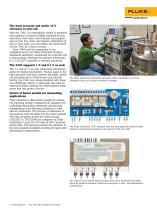
The most accurate and stable 10 V reference in your lab With the 734C, it is remarkably simple to establish and maintain a primary voltage standard in your laboratory. Over time, with frequent intercomparisons of your four units, and regular calibrations of one or more units, you can reduce the uncertainty of your 734C by a factor of three. From 1984 until the acquisition of our Josephson Array, the Fluke Calibration Primary Standards Laboratory maintained its corporate volt in this manner, reducing the absolute uncertainty to ± 0.35 µV/V traceable to national standards. The 734C supports 1...
Open the catalog to page 2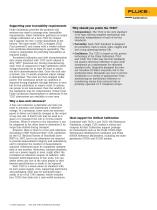
Supporting your traceability requirements Fluke Calibration provides the products and services you need to manage your traceability requirements. Fluke Calibration performs an output voltage calibration on a new 732C by comparing it against its own J-array maintained at the factory. The base model 732C is shipped COLD (“not powered”) and comes with a voided calibration certificate demonstrating its operability. The owner is responsible for providing traceability as required locally. Accredited calibration and drift characterization data comes standard with 732C units ordered to ship “HOT”...
Open the catalog to page 3
Taking your reference to the workload Standards laboratory operations have changed. In the past, people brought their workload to the standards lab. Today, the functions of the standards lab are being distributed, requiring that many calibrations be performed in the field. The 734C, and its electrically and mechanically independent 732C Standards, are designed to meet that need. The voltage reference remains undisturbed in your laboratory, while at the same time you can distribute the volt to remote locations outside the lab. When the unit is returned to the lab, comparisons can be made to...
Open the catalog to page 4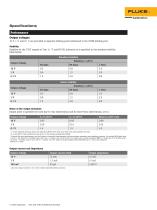
Specifications Performance Output voltages 10 V, 1 V, and 0.1 V are provided at separate binding posts referenced to the VCOM binding post. Stability Stability for the 732C outputs at Tcal ±1 °C and IN CAL indicator on is specified in the standard stability table below. Standard stability Output voltage Select stability Output voltage Noise at the output terminals Output noise is specified for both day-to-day observations and for short-term observations, at k=1. Output voltage S1 is the standard deviation about the regression (SDEV) of 90 days of at least twice daily stability test data. 2...
Open the catalog to page 5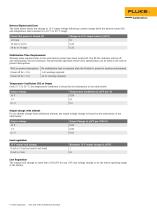
Retrace (Hysteresis) Error The table below shows the change in 10 V output voltage following a power outage (with the battery turned off) and temperature held constant in a 23 °C to 35 °C range. Period that power is turned off Change in 10 V output value (± μV/V) Stabilization Time Requirements Warmup times required after ac line and battery power have been turned off. The IN CAL indicator will be off, and recalibration will be necessary. The previously-specified retrace error specification can be used in the case of power interruptions. With no power interruption No stabilization time is...
Open the catalog to page 6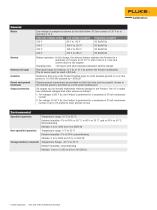
General Mains Line voltage is accepted as shown in the table below. AC line current at 120 V ac is typically 0.13 A. 732C line voltage setting Line voltage accepted Frequency accepted Battery operation: t full charge, the internal battery operates the Product for a A minimum of 72 hours at 23 ±5 °C, with 0 mA to 0.1 mA total current drain at the outputs. Charging time: <36 hours with self-contained automatic battery charger Rear-panel input for external 12 V dc to 15 V dc powers the Product indefinitely. The dc source must be rated ≥300 mA Resistance from any of the Product binding posts to...
Open the catalog to page 7
Ordering information The Product operates in Standards Laboratory environments where the radio frequency (RF) environment is highly controlled. International Standard models IEC 61326-2-1; CISPR 11: Group 1, Class A Controlled Electromagnetic Environment Group 1 equipment has intentionally generated and/or use conductively coupled radio-frequency energy which is necessary for the internal functioning of the equipment itself. Class A equipment is equipment suitable for use in all establishments other than domestic and those directly connected to a low voltage power supply network which...
Open the catalog to page 8All Fluke Calibration catalogs and technical brochures
-
9500C
9 Pages
-
6135A/PMUCAL
8 Pages
-
P5514B Hydraulic
3 Pages
-
Temperature Calibration
40 Pages
-
Field Metrology Wells
6 Pages
-
molbox1+™ Flow Terminal
6 Pages
-
Fluke Precison Measurement
24 Pages
-
Triple Point of Water Cells
4 Pages
-
Micro-Baths
2 Pages
-
Really Cold Baths
2 Pages
-
The “DewK” Thermo-Hygrometer
4 Pages

































